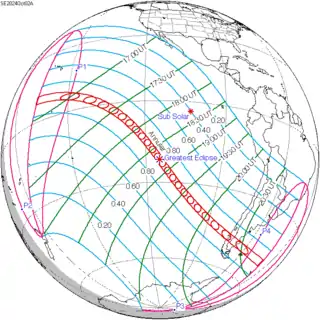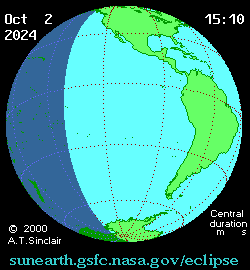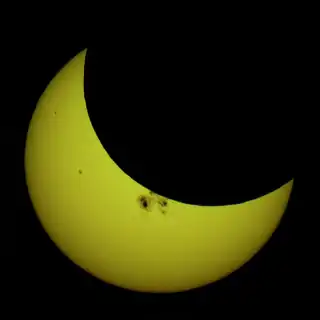Solar eclipse of October 2, 2024
An annular solar eclipse will occur on October 2, 2024. A solar eclipse occurs when the Moon passes between Earth and the Sun, thereby totally or partly obscuring the image of the Sun for a viewer on Earth. An annular solar eclipse occurs when the Moon's apparent diameter is smaller than the Sun's, blocking most of the Sun's light and causing the Sun to look like an annulus (ring). An annular eclipse appears as a partial eclipse over a region of the Earth thousands of kilometres wide.
| Solar eclipse of October 2, 2024 | |
|---|---|
 Map | |
| Type of eclipse | |
| Nature | Annular |
| Gamma | −0.3509 |
| Magnitude | 0.9326 |
| Maximum eclipse | |
| Duration | 445 s (7 min 25 s) |
| Coordinates | 22°S 114.5°W |
| Max. width of band | 266 km (165 mi) |
| Times (UTC) | |
| Greatest eclipse | 18:46:13 |
| References | |
| Saros | 144 (17 of 70) |
| Catalog # (SE5000) | 9562 |
Other than Easter Island and a small portion near the southern tips of Argentina and Chile and the north of the Falkland Islands,[1] the path of the eclipse's antumbra will be entirely over the Pacific Ocean. The penumbra will be visible from southern South America, Hawaii, the southwesternmost parts of Mexico (more specifically, Baja California del Sur and Jalisco), and portions of Antarctica. Approximately 175,000 people live in the path of annularity.[2][3] The eclipse’s magnitude will be 0.93261, occurring only 56 minutes before apogee.
The next solar eclipse occurs on March 29, 2025.
Images

Animated path
Details of the antumbra in some places or cities
| Country or Territory | Place or City | Start
of |
Start of annular eclipse (Local Time) |
End of annular eclipse (Local Time) |
Duration of annular eclipse |
End of partial eclipse (Local Time) |
Maximum darkness | Magnitude |
|---|---|---|---|---|---|---|---|---|
| Hanga Roa, Easter Island, Valparaíso Region | 12:23:49 | 14:04:05 | 14:10:24 | 6 min 19 s | 15:52:23 | 86,9% | 0,932 | |
| Tortel, Aysén Region | 15:56:48 | 17:20:04 | 17:26:24 | 6 min 20 s | 18:41:50 | 85,6% | 0,925 | |
| Villa O'Higgins, Aysén Region | 15:58:12 | 17:21:05 | 17:26:37 | 5 min 32 s | 18:41:49 | 85,6% | 0,925 | |
| Cochrane, Aysén Region | 15:57:55 | 17:21:15 | 17:27:09 | 5 min 54 s | 18:42:30 | 85,6% | 0,925 | |
| Gobernador Gregores, Santa Cruz Province | 16:01:02 | 17:22:40 | 17:28:28 | 5 min 48 s | 18:42:27 | 85,5% | 0,925 | |
| Puerto San Julián, Santa Cruz Province | 16:03:57 | 17:24:27 | 17:29:49 | 5 min 22 s | 18:42:48 | 85,4% | 0,924 | |
| Puerto Deseado, Santa Cruz Province | 16:06:06 | 17:27:12 | 17:30:58 | 3 min 45 s | 18:44:14 | 85,4% | 0,924 |
Related eclipses
The eclipse is a member of a semester series. An eclipse in a semester series of solar eclipses repeats approximately every 177 days and 4 hours (a semester) at alternating nodes of the Moon's orbit.[4] It is also part of Saros cycle 144, repeating every 18 years, 11 days, containing 70 events.
Eclipses of 2024
- A penumbral lunar eclipse on 25 March.
- A total solar eclipse on 8 April.
- A partial lunar eclipse on 18 September.
- An annular solar eclipse on 2 October.
References
- "An annular solar eclipse on October 2, 2024". earthsky.org. October 1, 2024. Retrieved April 9, 2024.
- "What the Eclipse Will Look Like near the Maximum Point". Time and Date. Retrieved May 12, 2024.
- Carter, Jamie (April 9, 2024). "Annular solar eclipse 2024: Everything you need to know about the next solar eclipse". Space.com. Retrieved May 12, 2024.
- van Gent, R.H. "Solar- and Lunar-Eclipse Predictions from Antiquity to the Present". A Catalogue of Eclipse Cycles. Utrecht University. Archived from the original on September 7, 2019. Retrieved October 6, 2018.
External links
- Earth visibility chart and eclipse statistics Eclipse Predictions by Fred Espenak, NASA/GSFC
.jpg.webp)

